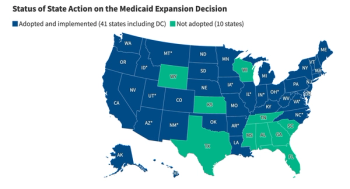
Access to healthcare worsens
The ability of adults to obtain basic healthcare services in the United States has declined in nearly every state over the last decade, especially among those without insurance, according to a report by the Robert Wood Johnson Foundation (RWJF).
The ability of adults to obtain basic healthcare services in the United States has declined in nearly every state over the last decade, especially among those without insurance, according to a report by the Robert Wood Johnson Foundation (RWJF). If the coverage provisions in the Affordable Care and Patient Protection Act are ruled unconstitutional, the researchers say they expect downward trends in access to continue.
Researchers at the Urban Institute base those predictions on three key health access indicators for adults aged 19 to 64: having unmet medical needs due to cost, having a routine check-up, and having a dental visit during the year. Researchers found a marked deterioration across those three measures between 2000 and 2010.
Adults without health insurance saw larger declines in the ability to obtain basic healthcare services compared to those with coverage. By 2010, almost half of uninsured adults (48.1%) had an unmet health need due to cost, compared to 11.2% of insured adults.
Over the past decade, rates of unmet medical needs rose in 42 states, according to the report. The share of adults receiving routine check-ups fell in 37 states; and the share of adults who had dental visits declined in 29 states. In all, 49 states experienced a significant decline on at least one of the three measures over the decade, researchers say. Only West Virginia and the District of Columbia did not.
“This report is sobering because it demonstrates how profoundly a lack of insurance translates into a lack of medical care,” said John Lumpkin, M.D., M.P.H. in a press statement. Lumpkin is senior vice president and director of the Health Care Group at the Robert Wood Johnson Foundation. “The Affordable Care Act will go a long way toward helping the uninsured access needed care, but this report also shows that those with insurance are avoiding care for many reasons, including costs.”
Nationally, the report finds that the share of adults experiencing unmet medical needs due to cost rose by 6% from 2000 to 2010 to 18.7% in 2010. Declines in access were more pronounced for the uninsured, with the share of uninsured adults experiencing unmet needs due to cost rising by 10.8% for the decade. States with the largest percentage of residents with unmet needs due to cost in 2010 were Mississippi (26%), Texas (25.3%) and Florida (25.1%). States with the lowest were North Dakota (8.2%), Massachusetts (8.7%) and Hawaii (9.7%).
The share of adults receiving a routine check-up decreased nationwide by 5.1% from 2000 to 2010, to 63.2% in 2010. The share of uninsured adults with a routine check-up fell by 11.6% to 37.9% in 2010.
The share of adults receiving a dental visit dropped by 3.9 percentage points between 2002 and 2010, to 65.2% nationwide in 2010. The share of uninsured adults with a dental visit fell by 9%, to 37.5% in 2010.
The Urban Institute report uses data from the federal government. Researchers compiled data from the Behavioral Risk Factor Surveillance System (BRFSS), which is derived from surveys conducted by state health departments with support from the Centers for Disease Control and Prevention (CDC).
Newsletter
Get the latest industry news, event updates, and more from Managed healthcare Executive.






















































